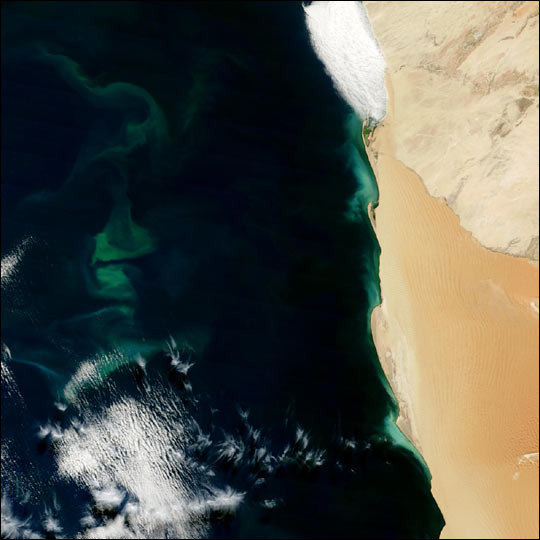나미비아 사막 연안 거주민들은 대서양으로부터 주기적으로 불어오는 황화수소가 분출될 때 발산되는 썩은 달걀 냄새에 익숙해져 있다. 이 MODIS 이미지는 2004년 5월 12일 분출을 보여주고 있다.
나미비아 사막 연안 거주민들은 대서양으로부터 주기적으로 불어오는 황화수소가 분출될 때 발산되는 썩은 달걀 냄새에 익숙해져 있다. 대부분의 산업이 어업에 치우쳐져 있는 이 지역은 대기 중에 이 불쾌한 냄새가 퍼질 때면 수 백만마리의 물고기가 떼죽음을 당하는 것도 자주 목격하고 있다. 그 냄새와 물고기의 떼죽음은 해저 지층의 부폐하는 식물들로부터 발산되는 황화수소가 그 원인이다.
대서양 남동부의 강한 해류는 영양이 풍부한 심해의 물을 수면으로 밀어 올린다. 이 해류는 플랑크톤이라 불리는 미시적 식물들과 다른 해양 생물들에게 영양을 공급한다. 플랑크톤이 죽으면 해양 바닥으로 가라앉고 박테리아는 분해를 시작한다. 산소는 이 부폐과정에서 빨리 소모되어 혐기성 박테리아가 생장하는데, 이 박테리아 활동의 부산물이 황화수소인 것이다.
해양바닥에서 만들어진 가스는 갑자기 분출되어 올라온다. 수면에 이르면, 수소는 산소와 결합하여 물이 되어 희고 단단한 황은 해양으로 떨어진다. 황화수소는 그 자체가 물고기들에게 독이 되며 산소와 반응하여 해양에 산소가 극히 희박한 상태로 만든다.
해수면위의 반응과 황화수소 분출은 위성사진으로도 보여진다. 흰색의 황은 빛을 반사하며 나미비아 해안을 밝은 초록빛으로 물들이고 있다. 2004년 5월 12일 나사NASA 테라 위성의 고분해능 기상센서Moderate Resolution Imaging Spectroradiometer (MODIS) 는 이 황화수소 분출과정을 촬영했다. 해안을 따라 해양의 연녹색 부분은 황화수소 가스가 분출되는 것을 보여준다. 해안 앞바다에서는 플랑크톤 블룸 (플랑크톤이 급격히 증가한 현상)이 밝은 녹색으로 소용돌이 치는 것이 보인다. 이런 높은 생장율은 죽음의 분출을 촉진한다.
이미지는 고분해능 기상센서 MODIS의 최대 해상도 250mpp 입니다.
추가 해상도 이미지는 이곳을 방문해 주세요. -> 클릭.
출처: http://visibleearth.nasa.gov/view_rec.php?id=19276

Metadata
* Sensor Terra/MODIS
* Start Date 2004-05-12
* Event Start Date2004-05-15
* NH Image ID 12123
* NH Event ID 10367
* NH Posting Date 2004-05-13
Credit NASA GSFC image courtesy Jacques Descloitres, MODIS Rapid Response Team
People living along Namibia's desert coast have long been familiar with the rotten egg smell that periodically emanates from the Atlantic Ocean whenever hydrogen sulfide erupts from the ocean. This MODIS image shows one such eruption on May 12, 2004.
People living along Namibia’s desert coast have long been familiar with the rotten egg smell that periodically emanates from the Atlantic Ocean. With an economy that is largely based on fishing, the locals are also used to seeing millions of fish die whenever the unpleasant scent fills the air. The smell and the fish die-off are caused by hydrogen sulfide erupting from decaying plants on the sea floor.
In the southeast Atlantic Ocean, strong ocean currents carry nutrient-rich deep-ocean water to the surface. The waters nourish free-floating microscopic plants,called phytoplankton, and other sea life. When the plants die, they sink to the ocean floor where bacteria begin to break them down. The oxygen is quickly used in the decay process, and anaerobic bacteria take over. These bacteria emit hydrogen sulfide gas as a by-product.
The gas builds on the ocean floor until it erupts suddenly. When it reaches the surface, the hydrogen combines with oxygen to form water,allowing solid white sulfur to precipitate into the ocean. Of itself,hydrogen sulfide gas is toxic to fish, but this reaction with oxygen also creates deadly low-oxygen conditions in the ocean.
The reaction at the surface also makes hydrogen sulfide eruptions visible in satellite imagery. The
white sulfur reflects light, tinting the water bright green along the Namibian coast. On May 12, 2004, the Moderate Resolution Imaging Spectroradiometer (MODIS) on NASA’s Terra satellite captured this image of a hydrogen sulfide eruption in progress. Along the coast, milky green sections of ocean show where hydrogen sulfide gas is coming up. Offshore, a phytoplankton bloom forms a bright green swirl in the ocean water, proof of the productivity that triggers the deadly eruptions.
Both the image above and the full image are at MODIS’ maximum resolution of 250 meters per pixel. The image is available in additional resolutions.
Source: http://visibleearth.nasa.gov/view_rec.php?id=19276

